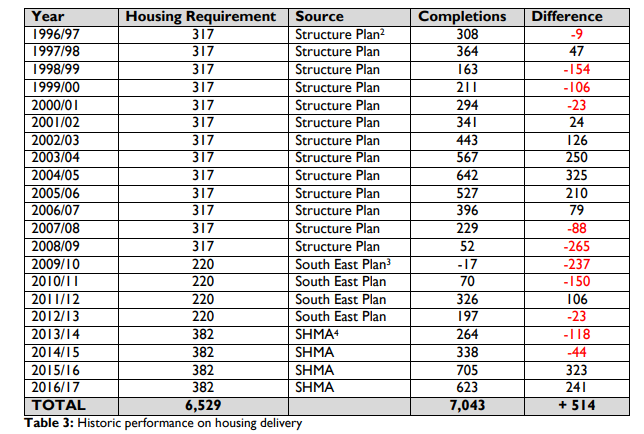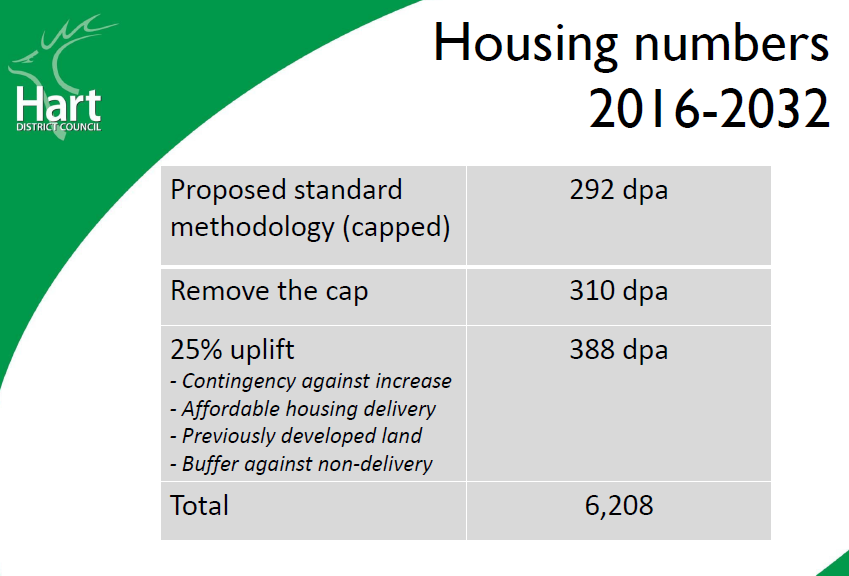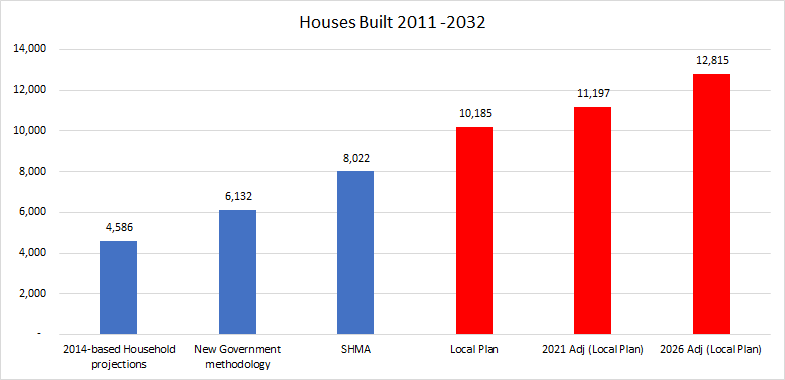This is the second part of our submission to the Regulation 19 Hart Local Plan consultation. This article explains why we are planning to build too many houses and why Policy SS1 needs to be amended to a more sensible target. The process for making a submission is as follows:
- Go to the Hart Local Plan Consultation page of the Council website
- From the Hart website, download and complete Response Form Part A (Personal Details). A copy can be downloaded here.
- Also download and complete the Response Form Part B (Your Representations), a separate Part B is required for each representation you wish to make. A copy can be downloaded here.
- Make sure you include words of this form in each representation. Policy [X] is not sound because it is not [positively prepared, justified, effective or consistent with national policy] (delete as appropriate).
- Once you have filled in Part A and Part B, please email them to [email protected] or post them to Planning Policy Team, Hart District Council, Harlington Way, Fleet, Hampshire, GU51 4AE.


First, the numbers proposed are far too high and they are unsustainable. Second, the long term effect of planning for too many houses is that the initial effects are compounded, leading to permanent unsustainability.
Proposed numbers in the Hart Local Plan are far too high and unsustainable
They propose 6,208 now homes over the plan period at a rate of 388dpa. This is both unnecessary and undesirable on a number of grounds:
The 2016 SHMA called for 8,022 new dwellings over the period 2011-2032. This was already too many. For reasons explained in more detail here:
- The starting point was inappropriate, using 2012 DCLG forecasts instead of the 2014-based figures.
- The affordable housing uplift was inappropriate because it was proposing to help those already renting but not able to buy. By definition, these people are already housed and therefore do not need an additional house to be built. Any arguments about building more houses increasing supply and thus reducing prices are spurious because any reasonable expectation of building will have only a negligible impact on prices. This is explained by Ian Mulheirn of Oxford Economics here.
- The jobs growth adjustment was inappropriate, anticipating higher rates of jobs growth than seen in periods of much higher economic growth. The SHMA then acknowledged that most of the extra people brought in by these extra houses will work outside the district. This is borne out by the M3 LEP Strategic Plan, which does not identify any part of Hart as either a ‘Growth Town’ or a ‘Step-Up Town’, so will be starved of investment. Moreover, the Employment Land Review (ELR) describes Hart’s office space as:
There appears to be an over-supply of lower grade stock with concentrations of dated, larger footprint, stock to the north of the town centre, specifically at Ancells Business Park, which is currently experiencing relatively high levels of vacancy.
Hook office space similarly experiences high vacancy rates and there is strong interest in office to residential conversion.
Commercial agents note that the costs of refurbishing such stock to a good standard attractive to the market typically costs between £50-£60 per sq ft; and that the current over-supply of office accommodation limits investment in refurbishing such stock as low rent levels made such investment unviable.
Clearly, this uplift was not an expression of the ‘need’ for the district. More importantly, building extra, unnecessary houses will then cause more people to move into the district. Because the employment space is sub-standard and not in a strategic location, these people will commute elsewhere each day to work. This is the very antithesis of sustainable development.
I think these arguments make clear that the target of 8,022 houses over the old plan period of 2011-2032 was unsound and unsustainable. This is further borne out by the analysis of Alan Wenban-Smith.
The current draft Local Plan calls for 6,208 houses to be built over the period 2016-2032. Hart built 1,830 houses over the period 2011-2016. This makes the total target over the comparable period 8,038 houses. This is more than the prior target in the SHMA despite the new Government method for calculating housing need showing a much slower rate of building being required. This is also unsustainable for the same reasons as above.
Basically, the council have found a way of arbitrarily adding back unnecessary houses without even the fig leaf of the flawed justifications used in the prior SHMA.
Their current proposal is for 6,208 houses or 388 dpa over the period 2016-2032. This is made up of the Government target of 292dpa. This figure itself is made up of the raw DCLG household projections plus an agreed ‘affordability uplift’ because Hart’s house prices are very high. They then remove the 40% cap on the affordability uplift and add and further 25% uplift to the result.
Their justifications for the 25% uplift are:
- Contingency against increase. I would suggest that adding to the housing target is an inappropriate way of dealing with this issue. It would be more appropriate demonstrate there is flexibility in housing supply to meet potential additional demand, rather than add extra demand without knowing it is there.
- Affordable housing delivery. This has already been accounted for in the 292dpa Government figure. In any event, as discussed above, building more won’t make a significant difference to house prices, and so won’t make houses any more affordable for people already living here, so it’s a spurious argument.
- Previously developed land. We have no idea what this means.
- Buffer against non-delivery. Again this is a spurious argument. The way to deal with this issue is to demonstrate flexibility in supply, not add additional demand.
Taken together their reasons are spurious and do not stand up to any sort of scrutiny.
Faster building doesn’t make prices more affordable
As an aside, the actual rate of building in the period April 2011 to March 2016 is 1,830/5 = 366 dpa. This is well above both the raw demographic change in the Government household forecasts (208dpa) and the 292dpa rate to take account of the affordability uplift. We are constantly being told that we should be building ~250,000 houses per year across the country, and the 292dpa is Hart’s share of that. So, it would appear that Hart’s rate of house-building is also well above the pro-rata rate of house-building in the rest of England and Wales as we are constantly being told that the country isn’t building enough houses. According to the theory, this rate of over-building ought to result in at least a relative reduction in prices compared to the rest of the country.
However, examination of Land Registry data from April 2011 to March 2017 returns an interesting result.
|
Region |
Average House Price April 2011 | Average House Price March 2017 |
% Increase |
| England |
175,490 |
231,826 |
32.1% |
| England and Wales | 172,921 |
226,860 |
31.2% |
| Hart |
275,859 |
397,632 |
44.1% |
Despite having a very high rate of building, compared to the rest of the country, house prices in Hart have risen much more quickly. This effectively nails the lie that building more will effectively make houses more affordable.
Compounding effect results in permanent unsustainability
The new Government methodology to calculate housing need uses the latest demographic projections. They then add an adjustment for suppressed households and affordable housing. The affordable housing adjustment is based on local house prices compared to local earnings. Overall, they come up with a national target that is in-line with the anticipated future needs. It follows that if councils deviate significantly from these proposals, that overall demand and supply will be out of balance.
We argue that not only is Hart’s proposed housing number unsustainable in its own right, but that this unsustainability will be projected into the future ad infinitum. This is clearly an absurd result that needs to be challenged. This is illustrated below, using figures from the previous Reg 18 consultation, but the concept remains sound.
When the prior Hart Local Plan was calling for 10,185 houses to be built, we carried out some modelling to work out how the unsustainable rate of growth would be affected by reapplying the Government methodology at five year intervals from 2016.
Essentially, the Government figures work by projecting forwards the trends of the previous five years, to arrive at a household projection estimate. An affordability uplift is then applied to this result to generate the building rate required for the subsequent period. In areas with high house prices, like Hart, because building more will have negligibler impact on prices, the affordability uplift would be essentially compounded at each five year review point.
This could end up leading to massive increases in unnecessary housing requirements towards the end of the plan period. This will apply regardless of the starting point. However, if the starting build rate is artificially inflated, then this too will continue to be compounded into the future. We will be faced with still more housing, more people migrating into Hart and then working elsewhere. This is again the very definition of unsustainability.
An example of how this worked with the prior Local Plan housing target of 10,185 is shown in the chart below.
Essentially, it resulted in a rate of house-building that was more than double that set at the outset by the Government household projections. The effect will be less severe with the housing numbers proposed in the new Local Plan, but will nevertheless lead to significant, unsustainable over-building.
Therefore we believe that the starting point for the Local Plan should be no more than the Government’s target of 292dpa or 4,672 dwellings in total. Because it isn’t yet clear whether Surrey Heath can meet its requirement, we would be prudent and add a few hundred to this to give a round number total target of 5,100 houses.
Remedy to the Hart Local Plan: We would therefore suggest that policy SS1 be adjusted accordingly:
New Homes
Subject to the availability of deliverable avoidance and mitigation measures in respect of the Thames Basin Heaths Special Protection Area, provision is made for the delivery of at least 6,208 5,100 new homes (388 319 new homes per annum) between 2016 and 2032.


